Temperature Measurement and Numerical Prediction in Machining Inconel 718
Abstract
:1. Introduction
2. Experimental Setup
2.1. Lathe Setup and Instumentation
2.2. Pyrometer Design and Calibration Setup
2.3. Pyrometer Validation
3. Numerical Model
4. Experimental and Numerical Results
4.1. Experimental Results
4.2. Numerical Results
5. Conclusions
Acknowledgments
Author Contributions
Conflicts of Interest
References
- Pollock, T.M.; Tin, S. Nickel-Based Superalloys for Advanced Turbine Engines: Chemistry, Microstructure and Properties. J. Propuls. Power 2006, 22, 361–374. [Google Scholar] [CrossRef]
- Iturbe, A.; Giraud, E.; Hormaetxe, E.; Garay, A.; Germain, G.; Ostolaza, K.; Arrazola, P.J. Mechanical characterization and modelling of Inconel 718 material behavior for machining process assessment. Mater. Sci. Eng. A 2017, 682, 441–453. [Google Scholar] [CrossRef]
- Díaz-Álvarez, J.; Cantero, J.L.; Miguélez, H.; Soldani, X. Numerical analysis of thermomechanical phenomena influencing tool wear in finishing turning of Inconel 718. Int. J. Mech. Sci. 2014, 82, 161–169. [Google Scholar] [CrossRef]
- Devillez, A.; Le Coz, G.; Dominiak, S.; Dudzinski, D. Dry machining of Inconel 718, workpiece surface integrity. J. Mater. Process. Technol. 2011, 211, 1590–1598. [Google Scholar] [CrossRef]
- Polvorosa, R.; Suárez, A.; de Lacalle, L.N.L.; Cerrillo, I.; Wretland, A.; Veiga, F. Tool wear on nickel alloys with different coolant pressures: Comparison of Alloy 718 and Waspaloy. J. Manuf. Processes 2017, 26, 44–56. [Google Scholar] [CrossRef]
- Canteli, J.; Cantero, J.L.; Marín, N.C.; Gómez, B.; Gordo, E.; Miguélez, M.H. Cutting performance of TiCN-HSS cermet in dry machining. J. Mater. Process. Technol. 2010, 210, 122–128. [Google Scholar] [CrossRef]
- Byrne, G.; Scholta, E. Environmentally clean machining processes—A strategic approach. CIRP Ann. 1993, 42, 471–474. [Google Scholar] [CrossRef]
- Dudzinski, D.; Devillez, A.; Moufki, A.; Larrouquère, D.; Zerrouki, V.; Vigneau, J. A review of developments towards dry and high speed machining of Inconel 718 alloy. Int. J. Mach. Tools Manuf. 2004, 44, 439–456. [Google Scholar] [CrossRef]
- Pusavec, F.; Deshpande, A.; Yang, S.; M’Saoubi, R.; Kopac, J.; Dillon, O.W., Jr.; Jawahir, I.S. Sustainable machining of high temperature Nickel alloy—Inconel 718: Part 1—Predictive performance models. J. Clean. Prod. 2014, 81, 255–269. [Google Scholar] [CrossRef]
- Pereira, O.; Rodríguez, A.; Fernández-Abia, A.I.; Barreiro, J.; López de Lacalle, L.N. Cryogenic and minimum quantity lubrication for an eco-efficiency turning of AISI 304. J. Clean. Prod. 2016, 139, 440–449. [Google Scholar] [CrossRef]
- Tazehkandi, A.H.; Pilehvarian, F.; Davoodi, B. Experimental investigation on removing cutting fluid from turning of Inconel 725 with coated carbide tools. J. Clean. Prod. 2014, 80, 271–281. [Google Scholar] [CrossRef]
- Suárez, A.; López de Lacalle, L.N.; Polvorosa, R.; Veiga, F.; Wretland, A. Effects of high-pressure cooling on the wear patterns on turning inserts used on alloy IN718. Mater. Manuf. Processes 2017, 32, 678–686. [Google Scholar] [CrossRef]
- Le Coz, G.; Dudzinski, D. Temperature variation in the workpiece and in the cutting tool when dry milling inconel 718. Int. J. Adv. Manuf. Technol. 2014, 74, 1133–1139. [Google Scholar] [CrossRef]
- Kus, A.; Isik, Y.; Cakir, M.C.; Coşkun, S.; Özdemir, K. Thermocouple and Infrared Sensor-Based Measurement of Temperature Distribution in Metal Cutting. Sensors 2015, 15, 1274–1291. [Google Scholar] [CrossRef] [PubMed]
- Rinaldi, F.; Najafi, B. Temperature Measurement in WTE Boilers Using Suction Pyrometers. Sensors 2013, 13, 15633–15655. [Google Scholar] [CrossRef] [PubMed]
- Garcia-Gonzalez, J.C.; Moscoso-Kingsley, W.; Madhavan, V. Tool Rake Face Temperature Distribution When Machining Ti6Al4V and Inconel 718. Procedia Manuf. 2016, 5, 1369–1381. [Google Scholar] [CrossRef]
- Ueda, T.; Sato, M.; Hosokawa, A.; Ozawa, A. Development of infrared radiation pyrometer with optical fibers—Two-color pyrometer with non-contact fiber coupler. CIRP Ann. Manuf. Technol. 2008, 57, 69–72. [Google Scholar] [CrossRef]
- Beno, T.; Hulling, U. Measurement of Cutting Edge Temperature in Drilling. Procedia CIRP 2012, 3, 531–536. [Google Scholar] [CrossRef]
- Miguélez, H.; Zaera, R.; Rusinek, A.; Moufki, A.; Molinari, A. Numerical modelling of orthogonal cutting: Influence of cutting conditions and separation criterion. J. Phys. IV 2006, 134, 417–422. [Google Scholar] [CrossRef]
- Tapetado, A.; Diaz-Alvarez, J.; Miguelez, H.; Vázquez, C. Fiber-Optic Pyrometer for Very Localized Temperature Measurements in a Turning Process. IEEE J. Sel. Top. Quantum Electron. 2017, 23, 1–6. [Google Scholar] [CrossRef]
- Tapetado, A.; Diaz-Alvarez, J.; Miguelez, M.H.; Vázquez, C. Two-Color Pyrometer for Process Temperature Measurement During Machining. J. Light. Technol. 2016, 34, 1380–1386. [Google Scholar] [CrossRef]
- Vázquez, C.; Tapetado, A.; Miguélez, H.; Díaz-Álvarez, J. Pirómetro de Fibra Óptica a Dos Colores. Patent ES P201530546/5209ES, 22 April 2015. [Google Scholar]
- Kops, L.; Arenson, M. Determination of Convective Cooling Conditions in Turning. CIRP Ann. Manuf. Technol. 1999, 48, 47–52. [Google Scholar] [CrossRef]
- Vernaza-Peña, K.M.; Mason, J.J.; Li, M. Experimental study of the temperature field generated during orthogonal machining of an aluminum alloy. Exp. Mech. 2002, 42, 221–229. [Google Scholar] [CrossRef]
- Komanduri, R.; Hou, Z.B. Thermal modeling of the metal cutting process: Part I—Temperature rise distribution due to shear plane heat source. Int. J. Mech. Sci. 2000, 42, 1715–1752. [Google Scholar] [CrossRef]
- Schmidt, A.O.; Roubik, J.R. Distribution of heat generated in drilling. Trans. ASME 1949, 71, 242–245. [Google Scholar]
- Cuesta, M.; Aristimuño, P.; Garay, A.; Arrazola, P.J. Heat transferred to the workpiece based on temperature measurements by IR technique in dry and lubricated drilling of Inconel 718. Appl. Therm. Eng. 2016, 104, 309–318. [Google Scholar] [CrossRef]
- Rowe, W.B.; Black, S.C.E.; Mills, B.; Qi, H.S.; Morgan, M.N. Experimental Investigation of Heat Transfer in Grinding. CIRP Ann. Manuf. Technol. 1995, 44, 329–332. [Google Scholar] [CrossRef]
- Hahn, R.S. The relationship between grinding conditions and thermal damage in the workpiece. Trans. ASME 1956, 78, 807–810. [Google Scholar]
- Shaw, M.C. A new theory of grinding. Mech. Chem. Eng. Trans. Inst. Eng. (Aust.) 1972, MC8, 73–78. [Google Scholar]
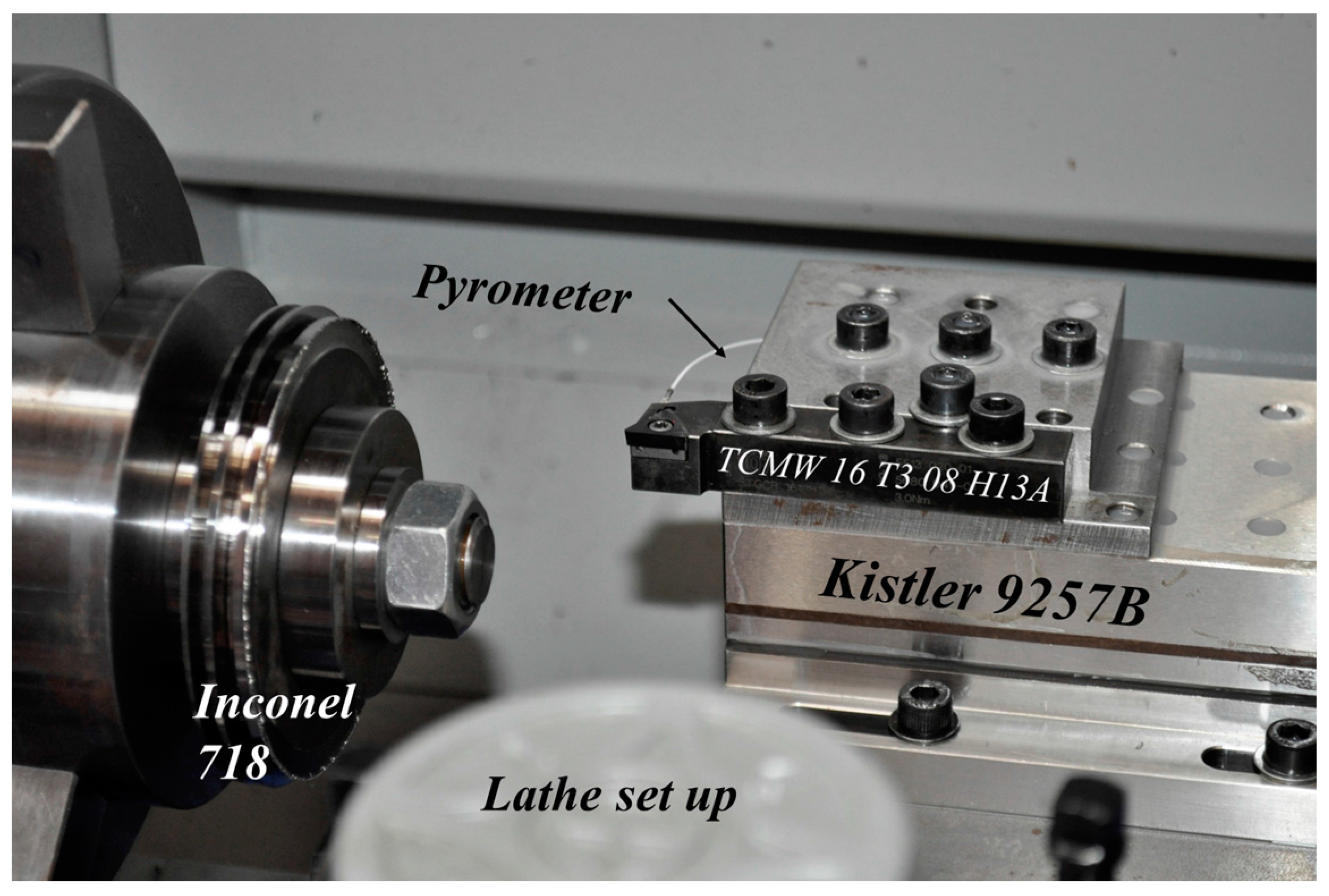

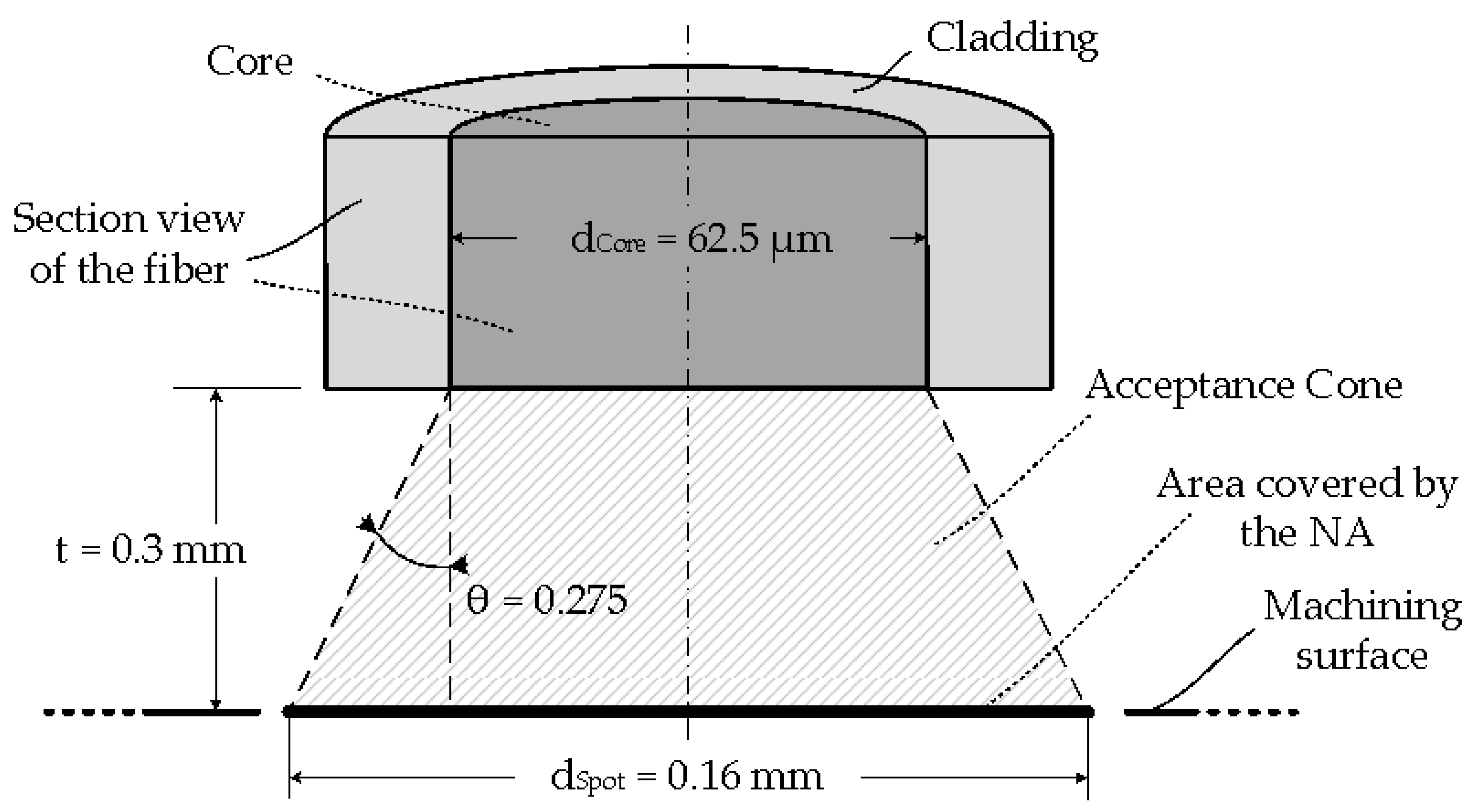

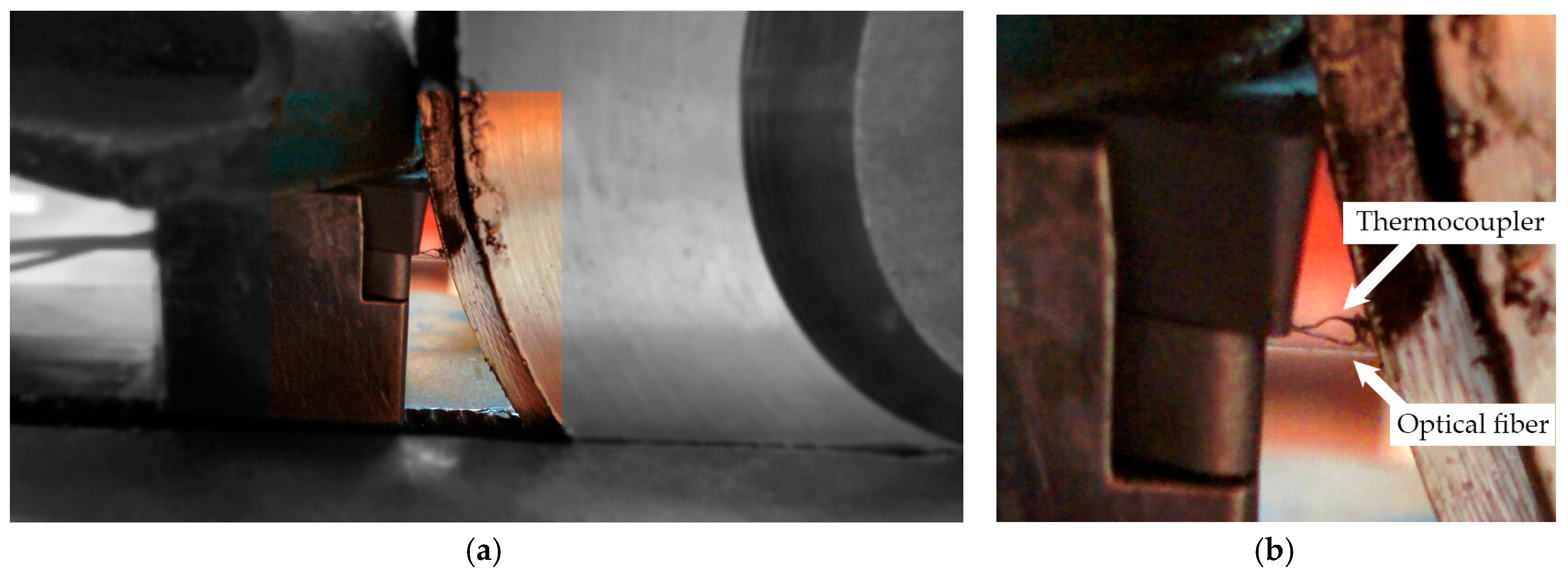

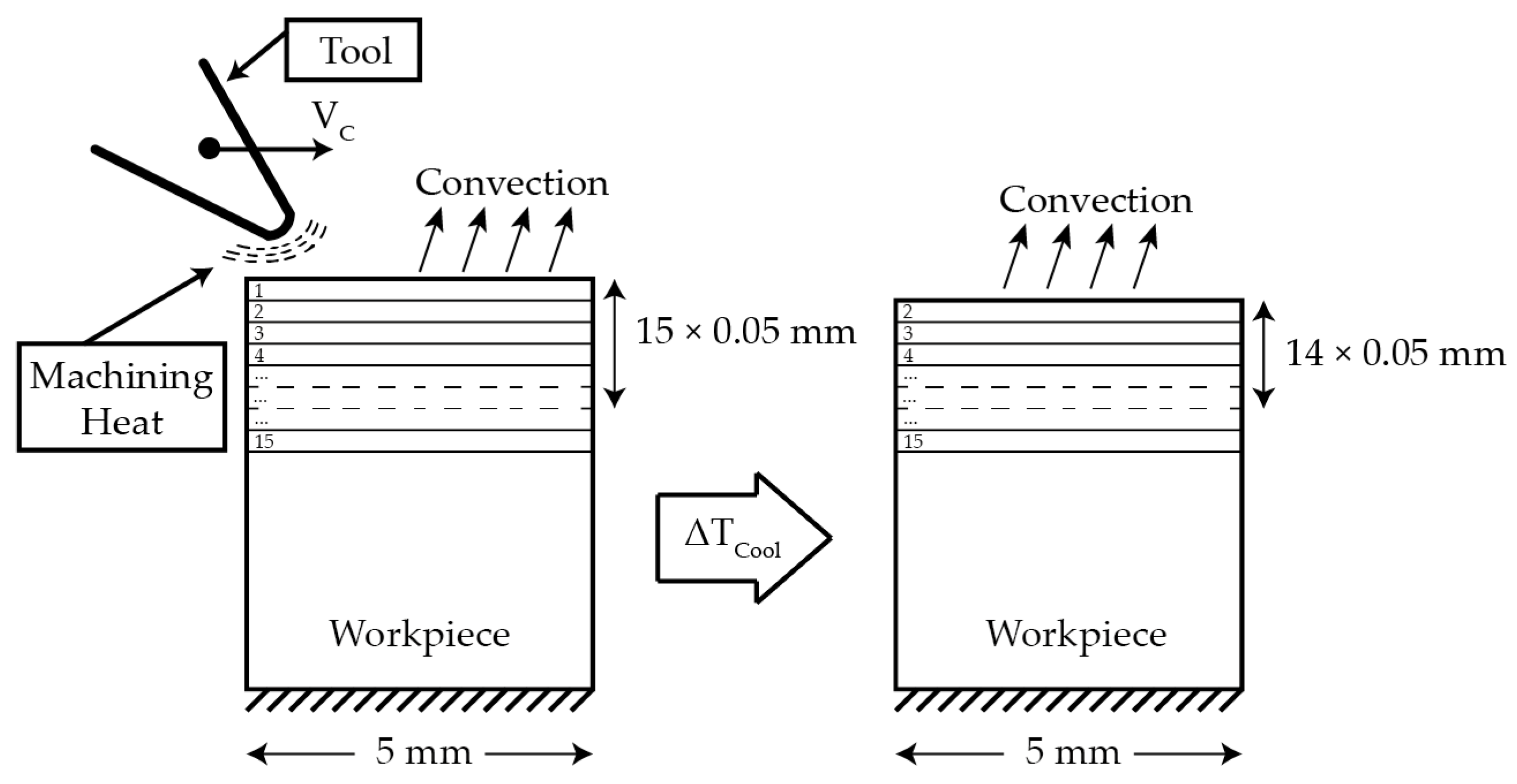


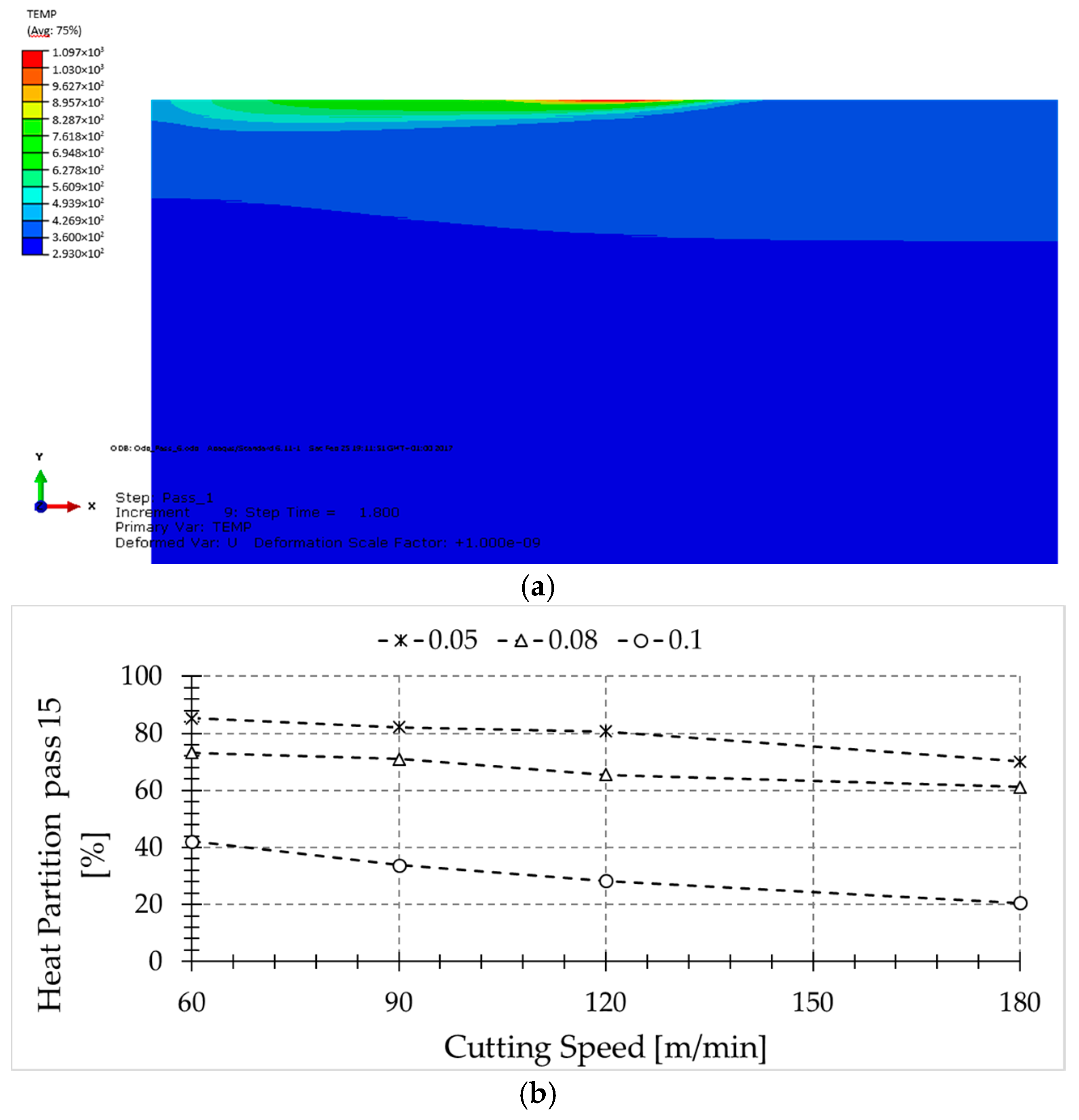
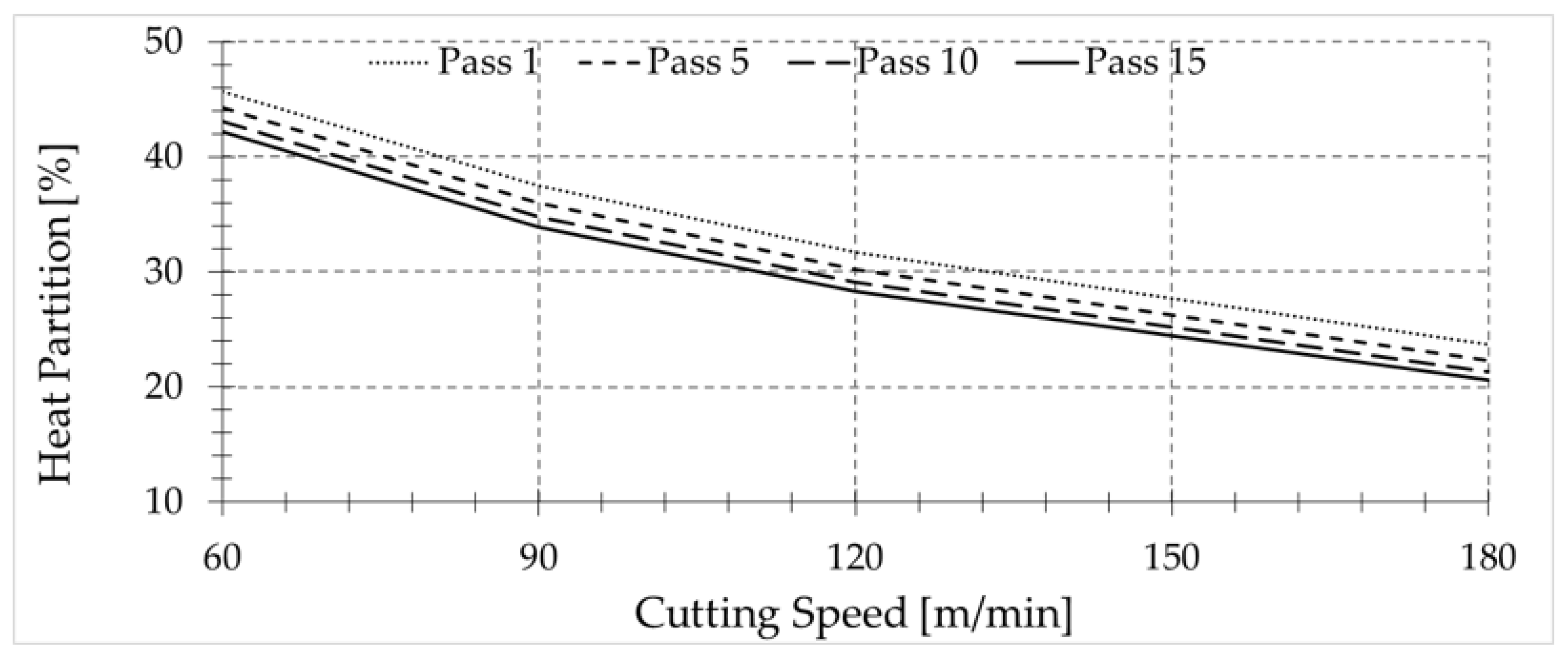

| Depth of Pass (mm) | Feed Rate (mm/rev) | Cutting Speed (m/min) |
|---|---|---|
| 2 | 0.05, 0.08 and 0.1 | 30 |
| 60 | ||
| 90 | ||
| 120 | ||
| 180 |
| Thermal Conductivity (W/m/K) | Temperature (K) |
|---|---|
| 10.31 | 293 |
| 11.88 | 373 |
| 13.6 | 473 |
| 16.6 | 673 |
| 20.1 | 873 |
| 26.3 | 1073 |
| 30.75 | 1573 |
| Specific Heat Capacity (J/kg·K) | Temperature (K) |
|---|---|
| 362 | 293 |
| 378 | 373 |
| 400 | 473 |
| 412 | 673 |
| 460 | 873 |
| 1073 | 1073 |
| 1573 | 1573 |
| Density (kg/m3) | Poisson Ratio | Modulus of Elasticity—293 K—(Gpa) |
|---|---|---|
| 8300 | 0.3 | 217 |
© 2017 by the authors. Licensee MDPI, Basel, Switzerland. This article is an open access article distributed under the terms and conditions of the Creative Commons Attribution (CC BY) license (http://creativecommons.org/licenses/by/4.0/).
Share and Cite
Díaz-Álvarez, J.; Tapetado, A.; Vázquez, C.; Miguélez, H. Temperature Measurement and Numerical Prediction in Machining Inconel 718. Sensors 2017, 17, 1531. https://doi.org/10.3390/s17071531
Díaz-Álvarez J, Tapetado A, Vázquez C, Miguélez H. Temperature Measurement and Numerical Prediction in Machining Inconel 718. Sensors. 2017; 17(7):1531. https://doi.org/10.3390/s17071531
Chicago/Turabian StyleDíaz-Álvarez, José, Alberto Tapetado, Carmen Vázquez, and Henar Miguélez. 2017. "Temperature Measurement and Numerical Prediction in Machining Inconel 718" Sensors 17, no. 7: 1531. https://doi.org/10.3390/s17071531





